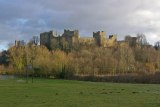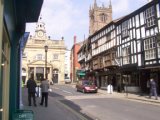Ludlow, Shropshire
The following article was first presented as one of the famous ‘Scrabble’ talks to members and friends of our Branch at a General Meeting. To encourage speakers from within the Branch, some draw a Scrabble tile from a bag and are asked to prepare a ten-minute talk on a subject with a Ricardian or medieval connection beginning with the letter they have drawn.
Ludlow (for a map, click here) is believed to be one of the series of castles built to hold back the unconquered Welsh. Walter de Lacy who was second in command to William Fitz Osbern, who came over with William the Conqueror, owned land around Ludlow in Shropshire, and began the building. His sons, Roger and later Hugh, built the earliest surviving parts of the castle.
 Ludlow Castle © Copyright Ian Capper and licensed for reuse under this Creative Commons Licence.
Ludlow Castle © Copyright Ian Capper and licensed for reuse under this Creative Commons Licence.
The de Lacy family retained the lordship until the end of the 13th century. This then passed to the Mortimers who had also arrived in England in the wake of the Conqueror.
During the civil wars in the reign of Stephen the King besieged the castle and actually rescued Prince Henry of Scotland.
In 1224 King Henry III met the Welsh border leader Llywelyn ab Iowerth, the Welsh Prince, at Ludlow to sign a treaty dedicated by Stephen Langton, Archbishop of Canterbury.
By the 14th century the castle was enlarged into a magnificent palace by Roger Mortimer, then the most powerful man in England. Roger (1287 – 1350) led the rebellion that forced the abdication of the inept Edward II and was instrumental in murdering King Edward while he was conducting an adulterous affair with Queen Isabella (the She-Wolf of France). Together they ruled as regents for the young Edward III until Roger was hanged on Tyburn Hill.
Edmund Mortimer (1391 – 1425) made an unsuccessful attempt to win the throne by persuading his cousin, Richard, Earl of Cambridge, a descendant of Edward II, to rebel. Richard was put to death, but Edmund survived.
Richard Plantagenet, Duke of York (1411 – 1460) made an attempt on the throne because his mother, Anne, was a Mortimer and his father, the Earl of Cambridge, who was leader of the Yorkists in the Wars of the Roses. He was involved in a number of battles including one at Ludford near Ludlow. His son won a decisive victory at Mortimers Cross and claimed the throne.
After Richard, Duke of York, had fled from Ludlow, his wife, Cecily, and two younger sons, watched the arrival of the King Henry VI’s troops from the steps of the market cross in the town. The youngest son was, of course, the future King Richard III.
After more battles in the Wars of the Roses, and the accession to the throne of the Duke of York’s eldest son as Edward IV, Ludlow became a royal palace. Edward sent his son, the Prince of Wales and, occasionally, his younger son to live at the Castle, which was also the seat of the Government of Wales and the Border Counties. Ludlow was, in effect, at the time the capital of Wales. Many apartments were given over to judges and administrators.
In 1501 Prince Arthur, son of Henry VII and Elizabeth of York, sister of the two Princes, spent the first six months of his marriage to Catharine of Aragon before his untimely death. Mary Tudor and her court spent three winters at Ludlow between 1525 and 1528.
The castle fortress occupied a finely judged defensive position on the ground about the Terne and Corve rivers. It was able to resist attacks from over the Welsh border. Stone was readily available and quarried from the well which reached to below the water of the River Terne. It incorporates a number of styles of building.
Since 1811 Ludlow Castle has been owned by the Earls of Powys who purchased it to help preserve the picturesque streets of the town that run right up to the castle and feature many half-timbered houses. In the 17th, 18th, and 19th centuries the fashionable people of Ludlow lived around the Castle.
For 900 years merchants have sold their wares in the Castle Square. Production of wool was the most important industry in medieval times. At first fleeces were sent over to Europe, but weaving and tailoring of fine clothes became the most important industry. Later woollen mills were built on the banks of the Terne River. Ludlow was also famous for leather-work and glove-making.
Ludlow Town Centre © Copyright David and Rachel Landin and licensed for reuse under this Creative Commons Licence
Today tourism is very important and an annual festival is held every midsummer.
And who that lists to walk the towne about
Shall find therein some rare and pleasant things
(Thomas Churchyard writing about Ludlow in 1578)
Ludlow had become the elite leisure centre of the middle marches in the 18th century and the castle was the focus of the burgeoning tourist industry … John Byng thought it was `one of the best towns for a genteel family of small fortune to retire to … Ludlow was thus one of the first tourist “honey pots” in England’
(From: Ludlow Castle, its history and buildings, edited by Ron Shoesmith & Andy Johnson; 2000, part of David Whitehead’s contribution)
And for a look at Ludlow in crime fiction try The Smile of a Ghost by Phil Rickman, one of the Merrily Watkins series. He always researches well, sticking to that area of the UK and all its legends. In it Bernie the Bishop of Hereford tells Merrily about Ludlow Castle when she mentions Catherine of Aragon:
“With the short-lived Prince Arthur … and then she married his brother, who became Henry VIII, and the rest is … Oh, the two ill-fated sons of Edward IV, they were here. The princes in the Tower. Here in happier times – presumably. People tend to be happy here.”
Tags: Castles, Family, Richard III, Shropshire


Leave a reply